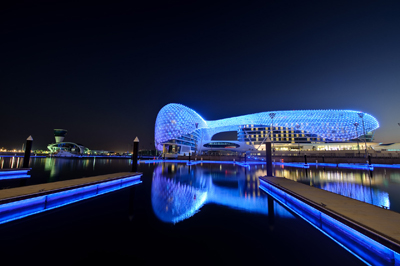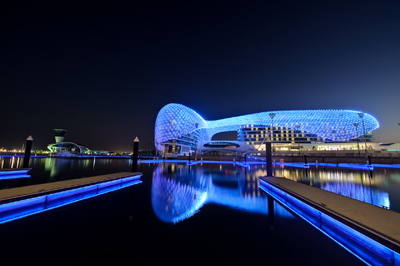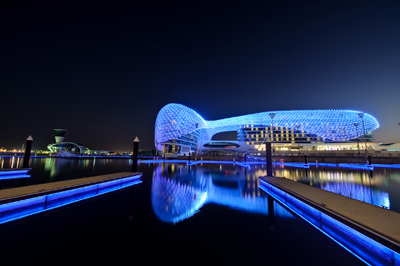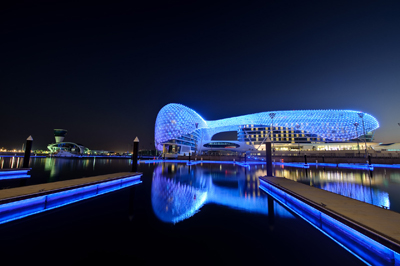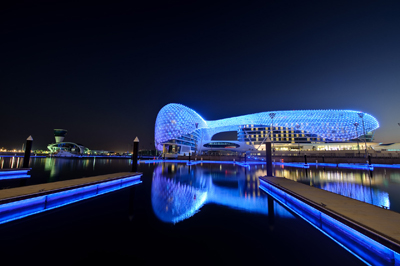by admin

Yas Marina Hotel in Abu Dhabi, UAE, by Asymptote with Dewan Architects and Engineers, and engineering by Arup.
Bjorn Moerman Photography
Event: Culture and Climate: Contemporary Architectural Responses in the Middle East
Speakers: Hana Kassem, AIA LEED AP—Director, Kohn Pedersen Fox Associates PC; Gordon Carrie, CEng, LEED AP —Associate, Arup; Anthony Fieldman, AIA, LEED AP—Design Principal, Perkins+Will; Paul Stoller, LEED AP BD+C—Director, Atelier Ten; Louise Harpman, Assoc. AIA—Clinical Associate Professor of Architecture, Urban Design, and Sustainability, New York University (moderator)
Organizer: Center for Architecture
Sponsors: A. Estéban & Co. (benefactor), Buro Happold (lead sponsor); Eytan Kaufman Design and Development, FXFOWLE (sponsors); Arup; Columbia University, Graduate School of Architecture, Planning and Preservation; Dewan Architects & Engineers; GAD; HDR; Kohn Pedersen Fox Associates; NAGA Architects; Ramla Benaissa Architects; RBSD Architects; Skidmore, Owings & Merrill; World Monuments Fund; Zardman (supporters)
Location: Center for Architecture, 03.01.2012
The more active global architecture firms become in the Middle East, the more complex and fruitful the exchanges of ideas are between regional traditions and the technologies, strategies, and assumptions of external cultures. The speakers at this panel, associated with the Change and City of Mirages exhibitions currently on display at the Center, emphasized the bidirectionality of these dialogues while taking account of the distinctive features that make the 16 Middle Eastern nations natural sites for certain types of projects, but sites of resistance to others. In projects for governmental, educational, and corporate clients around Western Asia—an alternative name, moderator Louise Harpman pointed out, for parts of the world that were first dubbed “the Middle East” by American and English naval and military strategists in the early 20th century—these firms have found productive ways of engaging with cultures that remain proudly resistant to being defined by outsiders.
Arup’s Gordon Carrie, CEng, LEED AP, explained some of the essentials of estidama, the sustainability principles that function under Abu Dhabi’s 2030 plan as the local equivalent of LEED standards. Since this region is one of the brightest places on Earth, Carrie noted, solar energy is a natural here; photovoltaics can be exceptionally efficient, particularly when integrated into holistically designed systems (and protected from sandstorms). The religious practice of ritual purification makes these nations relatively heavy users of water, and the scarcity of water resources means that gray-to-green infrastructural forms (rain gardens, sand filters, bioswales) have great potential, though cultural taboos make wastewater-reuse systems hard to implement—a phenomenon also found in New York, Atelier Ten’s Paul Stoller, LEED AP, noted.
Although the region includes eight climates as defined by the Köppen classification, intense sunlight is an unavoidable fact of life here. As the joint presentation by Stoller and Perkins+Will’s Anthony Fieldman, AIA, LEED AP, set out a series of important physical, cultural, and architectural qualities they have observed in the region, aridity—2-4 inches of rainfall per year—is an important principle connecting many of the others, such as protectiveness and modesty (expressed in the form of streets narrow enough to be self-shading, as well as home structures preserving social and gender separation), texture and intricacy (as in the elaborate geometries of mashrabiya screens), and a sense of discovery (embodied in contrasting compressed and open spaces). “The world’s hottest climate,” Fieldman noted, is “not something to be feared; it’s more something to rise to the occasion to.”
Structures that modulate gradual transitions in temperature through optimized apertures, reflective internal rather than external glazing, traditional tent-like forms, and other relatively low-tech approaches are generally successful here. Civic space as it’s understood in the West, KPF’s Hana Kassem, AIA, LEED AP, observed, has barely existed in Abu Dhabi, and malls, for better or worse, are one of the fast-developing forms of it. Her firm has looked to an older local tradition, the souk or open-air commercial quarter, as a model for the “media souk” in a new media production zone, twofour54 (named for the emirate’s latitude and longitude), where individual building components weave together to join at a central bazaar-like area, making the relatively novel “live/work/connect” mixed-use concept more culturally comprehensible.
The oil-rich nations of the region have been modernizing rapidly, in some cases too rapidly to take much heed of resource conservation as they have brought Western cooling technologies to their large-scale projects. Their leaders are avidly curious about some, though not all, design principles developed elsewhere, Fieldman reported. It is unrealistic for Westerners who have only recently “woken up from our energy binge,” in his phrase, to expect former nomadic cultures—in places whose primary economic activity a few decades ago was pearl diving, as Kassem noted about the United Arab Emirates—to adopt building technologies that strive to shield 100% of solar gain, or to eschew air conditioning, but the sense of environmental stewardship is increasing. The earlier-industrializing nations have much to offer, but also much to learn from Western Asia’s centuries-long experience managing the controllable and uncontrollable challenges of their world.
Bill Millard is a freelance writer and editor whose work has appeared in OCULUS, Icon, Content, The Architect’s Newspaper, and other publications.
